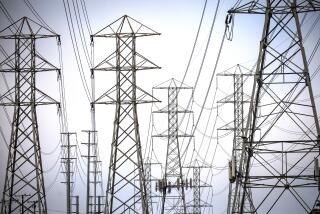Editorial: What’s to be done about energy rates?
In the crazy days of California’s 2001 electricity crisis — rolling blackouts! Enron! market manipulation! — the Legislature wisely imposed strict rules on how the state’s investor-owned utilities priced energy.
The idea was to protect residential ratepayers, especially those with low incomes, from the volatility of the electricity market while ensuring some revenue stability for the utilities. The result was the expansion of rate tiers from two to five, with higher rates for the top tiers and a freeze on rates for the lowest tiers — penalizing people who used the most electricity and rewarding those who used the least.
That was fine in the aftermath of a crisis, but it is not working so well 14 years on. The rate freeze meant that the burden on power guzzlers kept going up while the rate for sippers stayed the same, creating a rate structure that’s seriously out of whack. Also, the rules prohibit mandatory pricing schemes that set different rates at different times of the day, which are useful for encouraging non-peak use.
The California Public Utilities Commission is poised to adopt new residential rates, with the intention of making them more fair, less complicated and compatible with new and existing technology. Hooray for that — if it’s done in a way that doesn’t shift the burden too much or discourage Californians from saving kilowatts.
However, only one of the two rate reform proposals before the commission would do that — and it’s not the original plan worked out by two administrative law judges and supported by the big three utilities. About 75% of California’s power comes from Southern California Edison, Pacific Gas & Electric and San Diego Gas & Electric. Edison alone serves about 4.3 million residences. The big utilities like this option because they say it better reflects the true cost of power delivery. (The proposed changes do not apply to city-owned utilities, such as the Los Angeles Department of Water and Power.)
The original proposal would reduce the rate tiers to two and slash the price differential between them. It would also, starting as soon as 2019, add a fixed fee to every bill regardless of how much power was consumed ($10 for most people; $5 for qualifying low-income ratepayers), shifting costs even more. The big utilities say this would mean that people who consume little or no power — such as those who’ve installed rooftop solar panels on their houses — would nevertheless pay their fair share to connect to the grid.
But the result would be a significant reduction in monthly bills for the people who use the most electricity, paid for by a hefty increase charged to the people who use less — a hike of as much as hundreds of dollars more a year.
That’s crazy at a time when the state is scrambling to reduce greenhouse gas emissions. Such an extreme shift of costs from big users to smaller users sends a message to Californians that it’s OK to ease up on the conservation thing. It is not.
The commission should instead adopt the alternate rate reform proposal by PUC member Mike Florio. It is supported by the state’s Office of Ratepayer Advocate, much of the state’s solar industry, other green energy advocates and environmental groups, because it would shift costs less steeply and at a slower pace, thus retaining the conservation imperative.
This proposal would cut the tiers and cost difference between the rates too, but less dramatically. It would also allow utilities to charge $10 per month to those ratepayers who don’t use any power at all to ensure that they’re paying to connect to the grid.
It’s worth noting that both options would make it easier for utilities to begin charging “time of use” rates in the next few years, which would give consumers more control over their bills and work well with the new “smart” meters. Time-based pricing makes the cost of power more expensive during peak usage times and cheaper during off-peak times, allowing ratepayers to make smart decisions about when to charge their electric car or what time of day to run the clothes dryer.
The PUC can make a “smart” choice too, by adopting the rate reform proposal that moves toward fairness but not so quickly or harmfully that it jeopardizes conservation efforts.
Follow the Opinion section on Twitter @latimesopinion and Facebook
More to Read
A cure for the common opinion
Get thought-provoking perspectives with our weekly newsletter.
You may occasionally receive promotional content from the Los Angeles Times.










